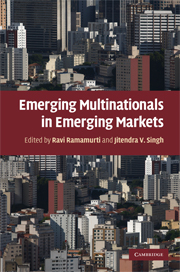Book contents
- Frontmatter
- Contents
- List of figures
- List of tables
- List of abbreviations
- List of contributors
- Acknowledgments
- Part I Introduction
- 1 Why study emerging-market multinationals?
- 2 Third World multinationals: A look back
- 3 Theoretical aspects of MNEs from emerging economies
- 4 Does firm ownership matter? POEs vs. FOEs in the developing world
- Part II Country Studies
- Part III Conclusions
- Index
- References
3 - Theoretical aspects of MNEs from emerging economies
from Part I - Introduction
Published online by Cambridge University Press: 03 July 2009
- Frontmatter
- Contents
- List of figures
- List of tables
- List of abbreviations
- List of contributors
- Acknowledgments
- Part I Introduction
- 1 Why study emerging-market multinationals?
- 2 Third World multinationals: A look back
- 3 Theoretical aspects of MNEs from emerging economies
- 4 Does firm ownership matter? POEs vs. FOEs in the developing world
- Part II Country Studies
- Part III Conclusions
- Index
- References
Summary
What is the current theoretical research agenda regarding the theory of latecomer or emerging economy MNEs? Currently the world's 500 largest MNEs dominate world trade and investment. In terms of FDI the world's largest firms account for 90 percent of the world total. In terms of trade they account for approximately half of world trade, as they often have a hundred or more foreign subsidiaries around the world. These data are well known to scholars in international business (see Rugman 2000 and 2005). It is through the activities of this set of very large MNEs that less developed countries are being integrated into the world's economic system.
The basic logic for this position is explained below in the next section where more details are provided about the nature and scope of the world's 500 largest MNEs. This is followed by data showing that these firms perform mainly on an intra-regional basis (rather than globally) and by data examining the specific activities of the relatively small set of large MNEs from emerging economies. These data are then integrated with the orthodox theory of MNEs to examine how MNEs from emerging economies can succeed in the world economy and act as flagship firms leading economic development.
Recent research in international business shows that FDI and the activities of MNEs are two-way streets.
- Type
- Chapter
- Information
- Emerging Multinationals in Emerging Markets , pp. 42 - 63Publisher: Cambridge University PressPrint publication year: 2009
References
- 7
- Cited by



